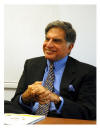|
|
the-south-asian.com April - June 2008 |
|
|||
|
People
|
|
||||
|
Ratan Tata – turning ‘impossible’ into possible! "Snubs have tended to spur the Tatas to greatness. When Jamsetji Tata, the group's founder, proposed making steel girders for the Indian railways in 1907, Sir Frederick Upcott, a colonial administrator, famously offered to eat every rail it made. A hundred years later, with Tata snapping up the remains of the British steel industry, westerners scoff at their peril, risking the wrath of a government and business community that sees the group, two-thirds of whose shares are held by charitable trusts, as a role model for corporate India.’ - Manuel Bueno, Financial Times Ratan Tata, the distinguished and dignified head of India's most respected conglomerate – the Tata Group – was the most visible face of India in 2007 and will perhaps remain so in 2008. Scion of a business dynasty, that gave India its first weaving mill, its first hydraulic power and steel plant, its first college, and its first luxury hotel, Ratan Tata, in his sixteen years in office, has turned the Tata Group into a global player and rebuilt and restructured a group of over 300 scattered ventures into a streamlined business empire with interests in seven major sectors. A man of many interests - reading, designing – Tata has two passions – cars and aircrafts. He was just seventeen when he got his pilots license and he has flown since – including an F-16 and a Boeing! "If there is anything I really regret, it is that we don't have an aircraft sector in our portfolio." The year 2007, began for the Tata Group, with Corus acquisition - the largest ever takeover of a foreign firm by an Indian company., and drew to an end with the possible ownership of the automoble industry's most prestigious brands – Jaguar and Land Rover - and the launch of the world's cheapest car at the Delhi Auto Show in early January - the "one lakh car" Nano. The automobile industry was initially worried that the takeover of Jaguar and Land Rover by the Tata group would lead to the end of these luxury brands in Britain. But Ratan Tata, speaking from the Geneva Motor Show in March 2008, said, "Our intention about Jaguar Land Rover is not to takeover the technology, not to outsource (production), but instead we are only interested in the brands and the cultures behind them. We plan to retain the image, touch and feel of these brands and not tinker with them in any way." Tata Motors is expected to sign a memorandum of understanding to buy Ford Motor’s Jaguar and Land Rover in mid-March. He also reassured the management: "We do not create a trauma within the company we take over. We do not slash costs or strip it. In every case, we have been keen that management stays and we have protected their autonomy." The management teams of the previously acquired companies — Corus Steel, Daewoo, Tetley tea and the Ritz-Carlton in Boston — are still in place. Tata shares a close manufacturing and marketing relationship with Fiat. Very soon Ferrari and Alfa Romeo (both Fiat-owned supercar brands), will be made available in India with the help of Tata Motors. Meanwhile, the people’s car Nano, made its international debut at the Geneva Motor show in March 2008. Ratan Tata, a Cornell-trained architect, helped design Nano, the much-awaited car which will sell in the Indian market for Rs100,000 ($2500). In what seemed to be an impossible target to achieve, amidst much scepticism from critics, Ratan Tata’s vision turned into reality – and now many of his critics are following his lead. The five-door hatchback Nano is expected to be in the market in the second half of this year. A shy and a gentle person, Ratan Tata has transformed the conglomerate since the time he took over sixteen years ago. The Group’s international portfolio has grown consistently and now has a global status – more than 60 per cent of its sales are overseas. He has the verve and élan to take on daunting and seemingly impossible challenges – and make them happen. He is the inspiration behind Nano. He talks to Christabelle Noronha about the making of, and issues surrounding Nano – and the realization and creation of a breakthrough into the small-car industry.
The interview on 'The Making of Nano'
|
|||||
|
Copyright © 2000 - 2008 [the-south-asian.com]. Intellectual Property. All rights reserved. |
|||||
